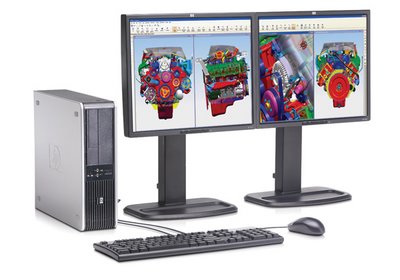Blade Workstations are exactly like standard workstations – insofar as they run desktop CAD/CAM/CAE applications, perform complex calculations and offer powerful 3D graphics – but instead of sitting under an engineer’s desk they are locked away in a secure data centre and accessed remotely by a thin client.
To understand what a Blade Workstation is, it’s best to think of it as a workstation with very long monitor, mouse and keyboard cables. All the calculations are carried out on the Blade and with the help of HP’s advanced Remote Graphics Software (RGS) it transmits display data over TCP/IP to a thin client which sits on the end user’s desk. The thin client simply displays this display data frame by frame in real time and feeds back mouse and keyboard input to the blade.
According to HP, on most networks, even on some high-speed Internet connections, latency is not a problem and when it’s lerss than 50ms it generally gives a similar experience as if you had a workstation sat underneath your desk.
HP’s Blade Workstations are rack mounted and will happily co-exist in the same rack as HP’s Blade Servers. In fact they are virtually identical to Blade Servers, the key difference being that they include a professional 3D graphics card. This gives them the ability to work with complex 3D models and manipulate them on screen. All of the 3D graphics processing is done on the Blade so the thin client only needs a modest 2D card.
HP has just released a new MCAD-focused Blade Workstation, which is certified to run a number of applications including, Catia, Siemens NX, PTC Pro/Engineer, Autodesk AutoCAD, Autodesk Inventor, and SolidWorks. It carries a Nvidia Quadro FX 1600M as its flagship graphics card, which is equivalent to a mid-range offering in most standard workstations.
So there’s the technology backgrounder, but what are the real world benefits of HP’s Blade Workstation solution?
Data management: One of the biggest advantages of HP’s Blade Workstation solution is that confidential data never leaves the data centre, which not only makes it more secure, but easier to manage. The thin client only ever receives pixel data transmitted from the Blade, so intelligent vector-based CAD/CAM/CAE geometry can’t be stolen or lost, or the wrong revision used. N.B. This is why the client only needs a 512MB solid state hard drive.
While this can be a huge benefit for single engineering departments it becomes even more relevant for multi-site enterprises, or those outsourcing design or manufacture. With a low latency connection it is possible to run Blade Workstations from the other side of the world, with all your data stored and managed in a central PDM system. This also lends itself well to collaborative design review as you don’t have to transfer large amounts of CAD data in advance. With the Blade you can access your data instantly.
Blade workstations also reduce desk-side hardware maintenance as each client box just needs to be configured with a standard OS disk image, independent of individual applications.
User flexibility: When a user logs on at a client they are hardwired to a Blade. Up to four blades can be accessed by a single client giving the user huge amounts of power at their disposal for complex analysis or rendering operations. With a multi-monitor set up each Blade can be assigned a screen, but rather than having to flick a switch the user simply moves the mouse onto the relevant screen to take control of the relevant blade.
Sessions can be maintained on the blade so users can move between clients simply my logging on at a different location. This can even be done at home on a standard laptop running HP’s RGS software. For example, a user could start an analysis job at the end of the working day, log on in the evening to interpret the results and tweak the design, then start a new simulation and then have the results ready for their arrival at work in the morning.
Environmental control: Powerful CAD/CAD/CAE workstations produce a lot of noise and heat and, if you put these under every engineer’s desk, managing this can be a major headache. Putting everything in a central location makes it easier to control but the downside is you have to invest in a dedicated data centre with its own power and air conditioning system, which is not cheap.
Conclusion
HP’s Blade Workstations are a high end solution, targeted at the enterprise rather than the SME. There’s a considerable investment required to get the infrastructure in place, but it’s clear that the benefits can be considerable.
It’s taken quite a while for HP to deliver an MCAD-specific system and part of this is down to securing essential certification from all the major CAD vendors. One also wonders if there have been technical issues as despite boosting the graphics performance with the introduction of Nvidia’s Quadro FX 1600M, this is not the high-end card that you would expect to find in an enterprise class MCAD workstation.
From streamlined collaboration to ultimate flexibility for users, HP’s Blade Workstation offers something new and exciting to the workstation sector. And for defence companies, or indeed any organization with sensitive design data, it’s certainly a compelling solution.
www.hp.com/go/bladeworkstations







